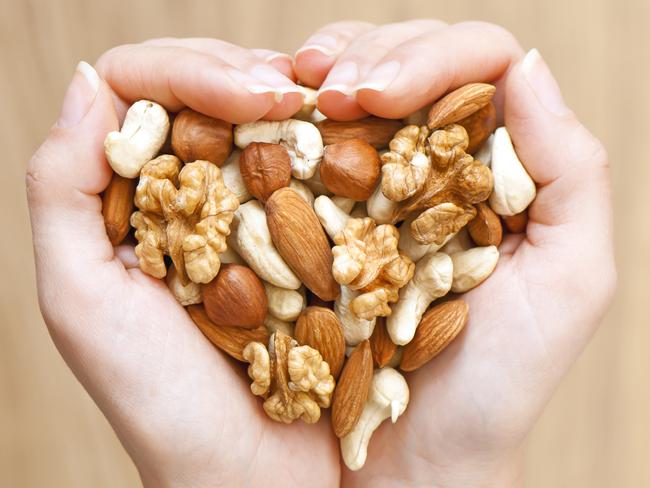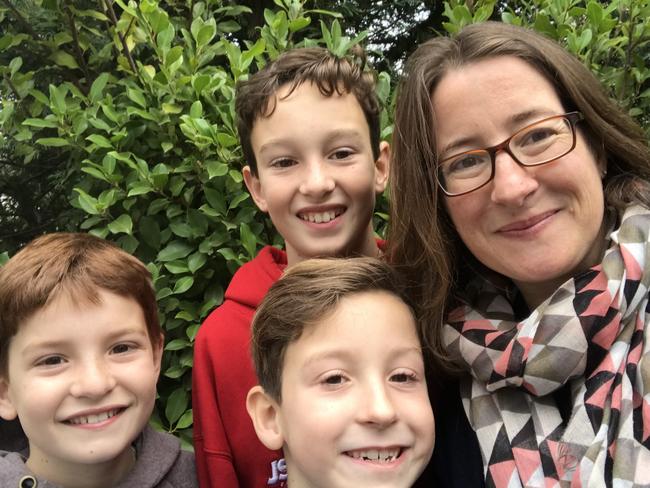New research to help prevent and treat asthma and food allergies in Australia
AUSTRALIA has one of the highest rates of allergies in the world, but it’s hoped research could soon help us better understand what triggers them.
Health
Don't miss out on the headlines from Health. Followed categories will be added to My News.
WHILE we’re no closer to seeing a decline in the number of kids being diagnosed with asthma and food allergies, new research is providing hope we may soon have a better understanding of their triggers — and how to better prevent allergies developing.
Today one in nine, or about 2.5 million, Australians are estimated to have asthma, up from one in 10 a decade ago. And in children the figure has been estimated as high as one in five. Food allergies are also over-represented in children, with an Australasian Society of Clinical Immunology and Allergy report finding up to 10 per cent of infants have a proven allergy.
And allergic diseases are considered to be one of the fastest growing chronic diseases in Australia, with a prediction by ASCIA that by 2050 the number of patients could increase by 70 per cent.
But new research is providing better insights into their possible causes, with hopes we’ll be better able to prevent and treat them within years.

Paediatric allergist Dr Richard Loh from the National Allergy Strategy says the high numbers in Australia, now also being seen in developing countries like India and China, are concerning. But we’re gaining a better understanding of the impacts of multiple contributing factors.
This includes advice once given by allergists not to introduce eggs, a food that can cause allergies, before the age of two and peanuts before the age of three, which while given with the best of intentions, Dr Loh says probably contributed to the increase in allergy sufferers.
What’s now known is that introducing these foods before 12 months can reduce the risk of allergies. It’s a message the NAS, in partnership with ASCIA, will soon begin promoting among child health services and parents.
MORE STORIES
RACHEL GRIFFITHS REVEALS AUSTRALIAN TV’S RACE SHAME
KRIS SMITH: THE NAKED TRUTH ABOUT MY LINGERING BODY ISSUES
And an established school of thought is what’s known as the hygiene hypothesis — the idea that our obsession with cleanliness is thought to contribute by not allowing children to build their immunity up naturally.
Vitamin D deficiencies are also being looked to as a possible factor, as are theories on changes in infants gut bacteria, with probiotics a growing research area.
“There’s a lot of research on the gut organisms showing they’re a bit different now and we’re probably too clean. The bacteria in babies’ guts is not the same as it was 30 years ago and that change is affecting how the immune system responds to foods and dust mites and pollen,” Dr Loh says.
Acknowledging the changing advice can be frustrating for parents. He urges avoiding “Dr Google” and finding reputable sources of information, adding the NAS is working to update pharmacists, nurses and GPs to avoid parents being given conflicting advice.

Allergy and Anaphylaxis Australia CEO Maria Said has seen an increase since she joined the charity in 1993, saying there’s “been a real surge” in both the numbers of children affected and the number of hospitalisations for anaphylaxis. Although she says it was prevalent in the 1990s, patients often self-managed by avoiding foods and she has concerns some adults who have never seen a specialist may be without emergency medication. But while awareness has also increased so too have waiting times for specialists, which for food challenges can be up to two years in some areas.
“It’s a triage system, if someone has had an anaphylaxis they’ll hopefully see a specialist sooner. But then people on the waiting list for mild or moderate reactions who might next time have an anaphylaxis are without emergency medication,” she says.
“We want people to be properly diagnosed because the prescription of an epi-pen is life changing, it’s quite a challenge, the specialists are doing the best they can but at the end of the day consumers are left waiting and needing support and direction.”
Asthma Australia CEO Michele Goldman says it’s a similar story for the airways disease, saying while knowledge has increased, there are still many unanswered questions.
What’s known is there’s a genetic component — a child has a 25 per cent chance of developing asthma if one parent has it and 50 per cent if both do.
Children exposed to tobacco smoke are also at higher risk. Those with food allergies and hay fever are also more prone to asthma, and where one isn’t properly managed, it can flare up the other.

Ms Goldman says while great progress has been made in managing asthma in young children by parents, school and childcare teachers, adolescents are a group of concern as they often slip into complacency once they’re instructed to self-manage their asthma.
“It’s the first time they’re becoming more independent and unless they’ve had some scary flare ups, generally we find complacency around asthma. They may think it’s not that serious or think they’re invincible, that it won’t happen to me,” Ms Goldman says.
“If they’re fit and healthy and full of life it’s very challenging to try and get them to talk about and acknowledge their disease, especially one that can be invisible.”
The organisation, working with the University of Sydney designed an app in consultation with young adults with the aim to address this. Kiss myAsthma, which allows patients to track symptoms, set goals and access a personalised asthma plan, with hopes offering a platform they’re comfortable with will engage them more.
While in the decade leading to 2016 the rate of hospitalisations among children aged 0-14 decreased and the overall rate of mortality remained steady between 2011-2015, it remains a leading reason children visit emergency departments.
The bacteria in babies’ guts is not the same as it was 30 years ago and that change is affecting how the immune system responds to foods and dust mites and pollen
But promising research to develop a vaccine, shown to be effective in mice, is being explored to see if it’s possible to replicate it in humans. And experts are also optimistic about studies of pregnant women showing that if their asthma is properly managed the likelihood of their child developing it can be almost halved. Paediatric respiratory specialist and consultant at Sydney Children’s Hospital Dr Louisa Owens says if properly managed, asthma sufferers should be able to lead full lives and the disease doesn’t have to be debilitating.
But where it’s not is where she sees kids end up in hospital.
“The children we worry about are those who need a lot of Ventolin,” Dr Owens says.
“They might be going to school and seem to be coping fine, but if they need it more than a couple of times a week, it’s a sign it’s not properly controlled.
“You should never rely on Ventolin to get through the day.”
For Julia Simmonds, her son’s eczema diagnosis at three months was just the start of learning to manage a host of allergies. She says:
“WHEN Christian was diagnosed with eczema we were told he’d grow out of it by his first birthday. That first year I was emotionally drained and isolated. We didn’t want to leave the house, we didn’t want people to ask about us and other children’s mums would steer their kids away thinking the rash was contagious.
Once at the post office someone directed me to the nearest hospital it looked that bad. I was trying to manage it with different products and taking on different advice from health professionals and it wasn’t work for us.
We saw several GPs, two paediatricians and I’m a pharmacist and were given different advice. I remember one GP said not to bathe him because it would irritate his skin, to do it only once a week. Another said to bathe every day because it would soothe the irritants on his skin. Simple things like that were really confusing.

When his first birthday came he was admitted to hospital for a week because his skin had become infected. At the same time he was diagnosed with asthma and hay fever and also later we realised he was anaphylactic peanuts and tree nuts. Getting on top of all of that has been challenging.
When he was about four he started asking questions about what his eczema was, why his skin was itchy, why did he have to moisturise.
Now he’s six he has a very good awareness and he’s starting to moisturise his own skin, getting him involved in the process has been important. He does his own asthma puffers in the morning and night and he’s beginning to be more independent in managing his conditions and better understanding them.
Starting school was a big time for us, especially with the food allergies. We teach him that certain foods will make him very sick and going through what that means. Unfortunately we had an anaphylactic episode when he was four and he remembers what that felt like, he knows the consequences and seriousness of being anaphylactic to foods.”
Sarah Foster’s three sons Max, 12, Billy, 11, and PJ, eight, have all had food allergies and she says the life-threatening nature of allergies needs to be taken more seriously.
“Max broke out in a rash when I first introduced eggs which kept getting worse. I took him to an allergist who diagnosed an egg allergy. I got Billy tested before I started solids and it showed he had a tree nut allergy. And PJ broke out in hives when he was given cow’s milk and was diagnosed with allergies to egg, dairy and nuts. He’s outgrown all but the nuts and Max outgrew the egg allergy.
PJ has had two anaphylactic reactions. One last year on a plane, we don’t know what to, there were no declared allergens in what he ate. Another a year before was to eggs.
We always carry four Epi-pens, two for each child and have them at home and at school and the kids are trained to use them.

In the beginning a specialist didn’t issue an Epi-pen for Max, back in 2009, which was really difficult. My child had just been diagnosed with a life threatening allergy but we didn’t have anything to manage it. But my GP said absolutely he needed one. That’s changed over time, they’re now prescribed more and instructions are to give the Epi-pen and give it early.
In the 11 years I’ve had a child with a life threatening allergy the information and support that’s come out in that time is amazing.
It’s really important the kids learn to live in the real world and to manage these on their own.
We have them ask if there’s nuts in foods and to check the ingredients themselves, we help them but they need to learn to do it themselves.
It’s always a scary thing, it really is that simple that they eat one wrong thing … it’s something all parents live with every day. We try to find that balance between alert and alarmed.
I think it’s really important the community is aware how serious it is. People think they’ll only get a sore tummy or feel unwell but unfortunately people can die.”
